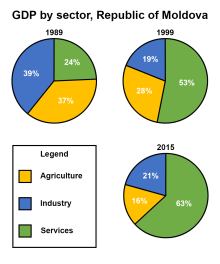Economy
Main article: Economy of
Moldova
Since the collapse of the Soviet Union, the
relative weight of the service sector in the economy of Moldova started
to grow and began to dominate the GDP (now about 75%), as a result of decrease
in industry and agriculture. The main economic indicators
contracted dramatically.As of 2009[update], Moldova has been described by the European Parliament as the poorest country in Europe in terms of GDP.
Energy
Moldova imports all of its supplies of petroleum, coal, and natural gas, largely from Russia. Moldova is a partner country of the EU INOGATE energy programme, which has four key topics: enhancing energy security, convergence of member state energy markets on the basis of EU internal energy market principles, supporting sustainable energy development, and attracting investment for energy projects of common and regional interestEconomic Reforms;
After the breakup of the Soviet Union in 1991, energy shortages contributed to sharp production declines. As part of an ambitious economic liberalization effort, Moldova introduced a convertible currency, liberalized all prices, stopped issuing preferential credits to state enterprises, backed steady land privatization, removed export controls, and liberalized interest rates. The government entered into agreements with the World Bank and the International Monetary Fund to promote growth.
Recent trends indicate that the Communist government intends to reverse some of these policies, and recollectivise land while placing more restrictions on private business. The economy returned to positive growth, of 2.1% in 2000 and 6.1% in 2001. Growth remained strong in 2007 (6%), in part because of the reforms and because of starting from a small base. The economy remains vulnerable to higher fuel prices, poor agricultural weather, and the skepticism of foreign investors.
Following the regional financial crisis in 1998, Moldova has made significant progress towards achieving and retaining macroeconomic and financial stabilization. It has, furthermore, implemented many structural and institutional reforms that are indispensable for the efficient functioning of a market economy. These efforts have helped maintain macroeconomic and financial stability under difficult external circumstances, enabled the resumption of economic growth and contributed to establishing an environment conducive to the economy's further growth and development in the medium term.

General Statistic Diagrams of Internet in
Moldova, in terms of download speed country ranked 9 in World
In 2005 (according to the Human Development Report), the registered GDP per capita was US $ 2,100 PPP, which was 4.5 times lower than the world average at the time (US $ 9,543). Moreover, GDP per capita was under the average of its statistical region (US $ 9,527 PPP). In 2005, about 20.8% of the population were under the absolute poverty line and registered an income lower than US $ 2.15 (PPP) per day. Moldova is classified as medium in human development and is at the 111th spot in the list of 177 countries. The value of the Human Development Index (0.708) is below the world average. Moldova remains the poorest country in Europe in terms of official (i.e., excluding the black and grey economy) per capita which currently stands at $1,808.729
The GDP in 2007 constituted $4.104 billion.That constituted a growth of 3% from 2006

